If Donald Trump gets sworn into office next January, he will be able draw on all the oaths he’s ever given during nearly half a century of suing — and being sued.
Over the course of Trump’s campaign to win the White House, he has made repeated references to his use of the courts, having regularly litigated against partners, governments, tenants, rivals and others over his more than 40-year real estate career.
And his presidential campaign hasn’t slowed that litigious streak.
Since announcing his candidacy in June, Trump has sued a business partner, Univision, for $500 million. In addition, he threatened to sue a rival, presidential candidate Ted Cruz, for not being a natural-born U.S. citizen.
He’s even discussed lawsuits he’d like to bring in the future, pledging that as president he would “open up libel laws” so “we can sue [newspapers] and win money.”
But as one attorney who has closely followed Trump’s legal maneuvers said, it’s not just about winning and losing. “Sometimes you sue because you want to win, other times you sue for delay, and sometimes you just sue to bully or get leverage. A lot of his suits are in the latter two categories,” said the lawyer, who asked to remain anonymous.
With that in mind, The Real Deal took a deep dive into Trump’s litigation history, focusing mostly on Manhattan real estate.
We reviewed hundreds of cases filed in Manhattan courts between the early 1980s and last month that involved Trump or one of his business entities.
Using public court records, TRD identified more than 90 cases in which Trump (or one of his entities) sued in New York County State Supreme Court on a real estate-related matter and more than 250 cases in which he (or one of his entities) was the one being was sued. (We eliminated all trip-and-fall-type suits as well as routine tax assessment appeals.) We also dug through old news reports and sifted through federal cases involving Trump.
Although in Manhattan he appears to have been disproportionally on the receiving end of most lawsuits, over the last four decades Trump has pushed a number of high-stakes real estate cases through the highest courts in New York. In at least one case, the fight has gone all the way up to the U.S. Supreme Court.
“Like many savvy New York real estate players, Donald Trump most certainly uses litigation as a tool to get what he wants,” said attorney Ray Hannigan, who represented Trump during the mogul’s 2002 sale of his stake in the Empire State Building.
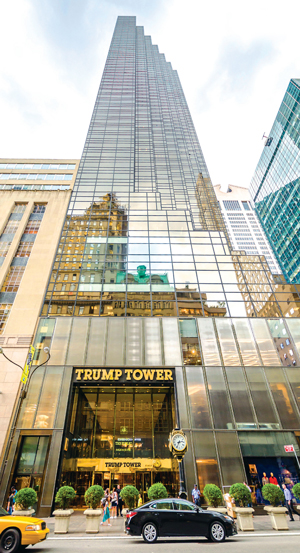
Trump Tower at 725 Fifth Avenue
Whether those experiences in the halls of justice predict presidential behavior is up for debate, but in the courthouse at least, Trump has shown himself to be more than willing to press opponents for as long as his attorneys will go along for the ride. And while he’s adamantly claimed on the campaign trail that he does not settle suits, these cases show that he has indeed done so on multiple occasions.
The suits also offer a window into his temperament — beyond the campaign bluster — and into how he would conduct himself as the leader of the free world.
Below is a look at decades of Trump’s legal battles and how he handled each one.
Trump v. Government
The ‘first’ 421a fight
Trump may be looking to run the government, but he’s also been one of its biggest gadflies. The GOP frontrunner has made a habit out of suing governments over the years. Experts say it’s hard to recall another presidential candidate who’s gone head to head with the government like Trump has, with the exception of the consumer rights advocate Ralph Nader. But Allan Lichtman, American University history professor and author of “The Keys to the White House,” noted that there is of course a “huge distinction” between the two men.
“Ralph Nader’s lawsuits are not for personal profit, they’re for the public interest,” he said.
Trump’s personal squabbles with the government, however, had far reaching public implications for the real estate community.
Trump’s fight with the city over 421a — a predecessor to the battle that’s making headlines today — is just one case in point.
It was that highly coveted developer tax cut that provoked Trump to sue Anthony Gliedman, the head of the NYC Department of Housing Preservation & Development, back in 1981 when Mayor Ed Koch was in City Hall.
Trump had been denied 421a tax relief to construct Trump Tower, a 58-story skyscraper built on the site of the Bonwit Teller building at 725 Fifth Avenue.
In those days, 421a did not require developers to include affordable housing, but it did require that prospective sites be “underutilized.”
When the city rejected Trump’s abatement, he took them to court. The city argued that the Bonwit Teller building did not meet the standard for “underutilized.” It also later contended that 421a was never meant to be tapped for luxury condos.
Lower courts twice ruled that Trump was due his 421a break. But when the Appellate Division of the Supreme Court sided with the city, Trump successfully took the case all the way to the New York Court of Appeals, the state’s highest court, where he won. The prize: a 10-year tax cut worth $50 million.
That wasn’t Trump’s only gain. He also hired Gliedman away from HPD to work for the Trump Organization.
When the battle was all over, Trump speculated that the Koch administration had been out to get him.
Attorney Jeffrey Golkin, a member of Trump’s legal team at the time, told TRD that the mogul was denied the tax break “because of who he was,” noting that the pressure on the government to avoid giving subsidies to billionaires was very real.
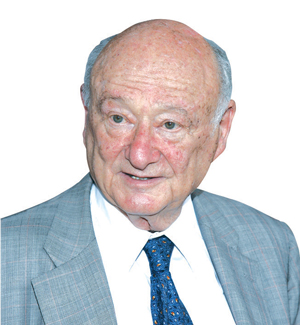
Mayor Ed Koch
In the end, Trump’s win carried more weight than could be measured by the coins being returned to his pockets.
It firmly established that luxury real estate projects were eligible for 421a, something that’s held true for more than 30 years — as evidenced by the recent (and highly controversial) tax breaks that went to Extell Development’s One57 and other luxury towers.
“It absolutely had an impact [on policy],” Golkin said.
In 1985, partially in response to Trump’s victory, the New York Assembly introduced the first affordability requirements to 421a, requiring Manhattan developers between 14th and 96th streets to build affordable housing in return for the abatement — a requirement expanded in the following decades.
Sources say Trump’s litigious history could inform how he handles adversity in office.
“[H]e will be used to it and more likely to give the go-ahead to have a fight if he feels like it’s necessary,” said Stanley Renshon, a political science professor at City University of New York, who has written three books analyzing the psychology of American presidents.
Going after capital gains
Trump’s 421a fight was not his only one with the government.
Around the same time that he was fighting City Hall, he also went after Albany.
In 1983, then-Governor Mario Cuomo enacted a new 10 percent capital gains tax on real estate sales over $1 million. Not surprisingly, Trump was not a fan of the so-called “Cuomo tax,” which would have applied to sales at Trump Tower.
Instead of merely grumbling about it among friends, Trump teamed up with developer Richard Pellicane and took on the governor’s tax commissioner, Roderick Chu. The duo claimed that the tax not only violated the state Constitution but also the U.S. Constitution because it exempted small property owners — an unfair carve-out in Trump’s view.
Chu, who told TRD that he worked with Cuomo and legislators to craft the new law, said that he had made extensive efforts to solicit input from across the real estate world but that he never heard from Trump.
“I guess he felt the way to do that was to not work with us and just sue me in court and get the whole thing thrown out,” Chu said.
When the lower court ruled against Trump, he doubled down and took the case to the Court of Appeals — with the Real Estate Board of New York squarely behind him. But the Appellate court dealt him another blow, ruling that the tax was perfectly constitutional.
Trump and his attorneys then pushed the case all the way up to the U.S. Supreme Court, where justices saw no “substantial Federal question” worth addressing and tossed the case.
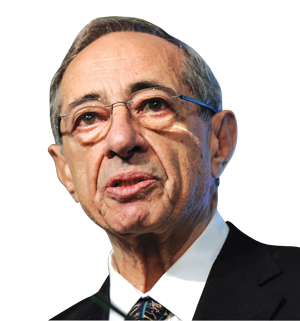
Governor Mario Cuomo
“We were confident of our position from the get-go,” recalled Bob Abrams, the New York State attorney general at the time, who urged the Supreme Court to reject Trump’s appeal. “The AG’s office successfully defended the legislature’s right to pass, and the governor’s power to sign into law, that tax.”
Chu, meanwhile, delighted in recounting the story.
“Now that’s he’s a candidate, I get to brag amongst my friends that Trump sued Chu all the way to the Supreme Court and Chu won,” he joked.
Even though Trump lost, he ended up winning in the court of electoral politics when New York descended into the 1990s recession.
In 1995, Cuomo, a Democrat, lost reelection to the Republican candidate, George Pataki. According to news reports, Cuomo cited the real estate tax as one possible reason for his defeat.
Blasting the Bloomberg administration
A few years later, in 2002, Trump again took on the government.
Amidst a tax assessment scandal in Michael Bloomberg’s administration in which 18 city property assessors were indicted in a multi-million dollar scheme to shave taxes for select landlords, Trump sued the city for $500 million. He argued that the corrupt practices had cost him in lost sales opportunities at his Trump World Tower condo development near the United Nations, necessitating lower-than-planned prices because taxes were too high.
He even threatened to sue the landlords that had benefitted from the allegedly inaccurate assessments — Leonard Litwin, Sheldon Solow and the Resnick family among them. But this time REBNY was considerably less charmed.
“These charges are outrageous and unfounded,” said REBNY’s then-president Steven Spinola.
Trump’s case went down at the Appellate level, but he got himself a settlement: The city agreed to cut 17 percent from Trump’s tax assessment at Trump World, as well as award the building a 421a abatement. In return, Trump agreed to subsidize 200 affordable housing units in the Bronx that another company, the Atlantic Development Group, was partnering with the city on.
“The lawsuit saved us approximately $97 million,” Trump wrote his 2004 book “How to Get Rich.” “We never would have gotten any of it if we hadn’t taken dramatic action.”
Trump’s entanglements with government entities are not limited to American shores.
In 2011, he sued the Scottish government for showing bias when it allowed a wind farm to be created along the coastline in view of Trump’s Aberdeenshire golf resort. He lost that one in 2015.
While Trump has licensing agreements worldwide — in countries like India, the Philippines and Uruguay — he does not appear to have sued any other foreign governments. Still, he may have to smooth over diplomatic relations with Scotland if elected.
Trump v. Tenants
Discrimination accusations
Trump’s first major foray into the legal system traces back to the early 1970s, when his father’s company, then called Trump Management, was accused of racial discrimination at rental buildings, mostly in Brooklyn and Queens.
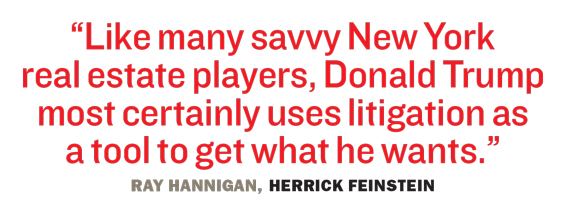 The U.S. Department of Justice spoke to witnesses who claimed that the Trumps used racial codes on rental applications to flag (and reject) minority applicants. For example, “Colored” was marked with a “C,” one witness charged.
The U.S. Department of Justice spoke to witnesses who claimed that the Trumps used racial codes on rental applications to flag (and reject) minority applicants. For example, “Colored” was marked with a “C,” one witness charged.
The Trumps did not take these accusations lying down. They sued the federal government for $100 million in damages. They settled the DOJ suit two years later in 1975, reaching an agreement with the Feds on how Trump Management would change its business practices.
As part of the agreement, Trump Management promised to adhere to a set of anti-discriminatory procedures and to provide the Urban League, the civil rights organization, with lists of rental vacancies on a regular basis.
But Trump later touted the settlement as a win.
“In the end, the government couldn’t prove its case, and we ended up making a minor settlement without admitting any guilt,” Trump later wrote in the “The Art of the Deal.”
If Trump wins the presidential election he will, of course, appoint the next U.S. attorney general, who heads the very Department of Justice that went after him all of those years ago.
And it could be said that the first case filed by the DOJ set Trump on course to tap the courts.
He later flipped the tables and took on tenants in Manhattan.
Making foes in Manhattan
When Trump left the outer boroughs for good in the late 1970s, he butted heads with tenants at some of his ambitious Manhattan development projects. Around the same time he was suing the city over 421a, he had another major project planned on Central Park South. He had just purchased two buildings — the 15-story rental building 100 Central Park South and the neighboring Barbizon Hotel — that he was planning to demolish to pave the way for one giant condo tower. The former of those buildings, however, was inconveniently full of rent-stabilized and rent-controlled tenants.
“No one has ever been successful at vacating a building in a super location like this,” Trump was quoted saying. “I’ll be the first.”
To empty the building, Trump filed a string of lawsuits against stubborn tenants, many of which were quickly dismissed. He also made a well-publicized attempt to move homeless New Yorkers into the building to push the building’s remaining tenants to leave. In 1984, a group of residents fired back and sued Trump for harassment.
Trump’s response? He sued the tenants’ lawyers — who were led by high-profile tenant attorney David Rozenholc — claiming they had violated the Racketeer Influenced and Corrupt Organizations Act, aka RICO, by helping tenants bring harassment charges against him. In the suit, Trump sought an astonishing $105 million. But in early 1986, the complaint was dismissed.
Rozenholc said that he had never seen such a suit — and hasn’t seen one like it since.
“It was not run of the mill. Not every developer sues attorneys representing the other side, or brings a RICO action in federal court for $105 million,” he said.
Having litigated his way to a stalemate, Trump finally struck an agreement with tenants: He wouldn’t evict them, he wouldn’t demolish the building, and he would only renovate units as they became naturally available. Trump, not surprisingly, attempted to quash any whiff of concession.
“They haven’t really won,” Trump spokesman Thomas Macari said at the time. “They’ve lost because they wanted to buy their apartments.”
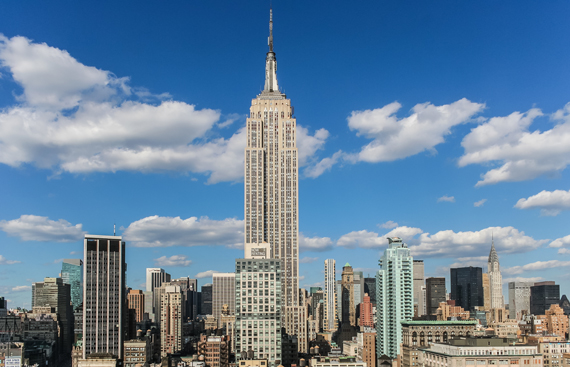
Empire State Building
More than a decade later, some of the building’s tenants would finally get that chance: 100 Central Park South became Trump Parc East Condominium, with longtime residents getting first dibs on buying their homes at discounted prices.
And by then, the once-incensed John C. Moore, who had led the residents’ group years earlier, had changed his tune altogether. “Donald Trump has acted like a gentleman for a long time now,” he told the New York Times in 1998.
Trump has also gone up against commercial tenants.
In 2005, luxury restaurant operator Cipriani sued Trump over un-refunded payments when its bid to buy the commercial condo at the Trump Park Avenue fell through. Years of conflicts with the Food Emporium at Trump Palace ended in multiple settlements; the most unique among them required the grocery store to do a twice-annual brass polishing.
Trump v. Partners/Rivals
The Empire State Building brawl
At one point or another, Trump has owned part, or all, of the Plaza Hotel, the Grand Hyatt, the GM Building, Riverside South and the Empire State Building. But he’s gone multiple laps around the courthouse with his partners at each property.
In 1994, Trump acquired a 50 percent interest in the Empire State Building from Japanese billionaire Hideki Yokoi for a paltry $100,000, according to the Wall Street Journal. But his presence had a very strategic purpose: Yokoi’s daughter, who was fighting with her father over control of their iconic investment, wanted Trump to help break the lease. And what better way to do that than to sue?
Indeed, a partnership between the Malkin and Helmsley families controlled a 114-year lease on the Empire State Building, meaning almost all the profits from rent would go to them and not to the owners. That’s where Trump came in.
Trump was brought in to sue the Malkins and Helmsleys. And he did so in spectacular fashion, with a price tag of $100 million, claiming they had allowed the prized landmark to become “rodent-infested” and a “high-rise slum.”
The suit, which provided much fodder for New York’s press corps, was a bold attempt to break a lease that was set to run until the year 2076. The Helmsleys and Malkins fired back with a $100 million suit, in which they hit Trump where it hurts most: his image. “Trump has no meaningful financial resources of his own” and is “now known mostly as a celebrity,” the claim read.
Neither side got their $100 million, and Trump and Yokoi both sold their stakes to the Malkins in 2002.
“I think most people doubted that Trump’s lawsuit would go anywhere. It’s incredibly difficult to break a ground lease in New York,” said Hannigan, who represented Trump in the eventual sale.
Trump, however, had little to lose and a lot to gain. In addition to buying his stake at a nominal fee, he had negotiated a deal with Yokoi to get 50 percent of the sale for anything over $45 million. When the partners sold to the Malkins, the price was $57.5 million — meaning Trump earned more than $6 million. “[It] ultimately paid off handsomely for Mr. Trump,” Hannigan said.
Still, while he may have gotten a big payday, he lost the building.
“I’m sure he wanted to hold on to the icon, and that was his goal; that’s how he thinks,” said one attorney, who asked to remain anonymous.
‘Grand’ ambitions
Meanwhile, in 1993, just before his Empire State Building acquisition, Trump slapped his partner, hotel magnate Jay Pritzker, with a $500 million suit, claiming that Pritzker was trying to force him out of their partnership at the Grand Hyatt on East 42nd Street.
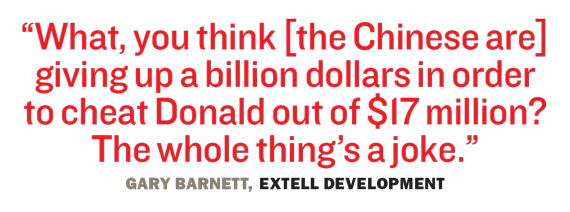 Pritzker had wanted Trump to evenly split the $37 million in renovations being done at the site. But that was $18.5 million that Trump, who was in hot water with his creditors in Atlantic City, may not have had at the ready.
Pritzker had wanted Trump to evenly split the $37 million in renovations being done at the site. But that was $18.5 million that Trump, who was in hot water with his creditors in Atlantic City, may not have had at the ready.
“As Donald saw it, and he may have been right, Pritzker knew Trump had no money because it was all over the papers that he was on the verge of bankruptcy,” one lawyer recalled. “So since Donald couldn’t make his partnership share of those [renovation] payments, he would have lost his interest in the hotel. So he sued them.”
Trump also claimed that Pritzker had siphoned millions from the hotel and overstated profits. Pritzker countersued for $100 million, saying that Trump had tried to block hotel renovations by not paying his share.
The two settled in 1995 and the following year Trump sold his interest in the Hyatt to Pritzker for $140 million. “It’s both a very happy and very sad day,” Trump told the Times.
GM goals and West Side dreams
In a more famous example of sue-then-sell from 2001, Trump went after his then-partner Conseco Inc., the financial firm, to the tune of $1 billion for refusing to sell him the GM Building. Trump was later successfully able to force a settlement, despite the fact that an arbitration panel had ordered him to sell his stake in the building to Conseco for $15.6 million. Sources at the time told the New York Post that Trump may have made out with over $100 million as part of the settlement agreement, but the New York Times reported that his payout was expected to be “modest” when Conseco sold the building.
Fast forwarding to 2005, Trump took on one of his biggest (and now most well-known) fights — this one on Manhattan’s West Side.
Extell Development, Carlyle Group and partners had entered into contract to buy a 13-block-long development site known as Riverside South for $1.76 billion. Trump had first optioned the site in 1974, and he had already built on it, erecting a collection of condo buildings known as Trump Place with partners led by Hong Kong billionaire Henry Cheng.
Trump was by then only a minority owner in the available land and did not know that his partners, the majority stakeholders, had agreed to sell the property. When he did find out, he took action. Despite the expectation that he would get a hefty $500 million out of the sale, he sued the partners for $1 billion for allegedly underselling the site and thus violating their fiduciary duty to seek the highest possible price.
According to Trump’s suit, Cheng and others didn’t consider offers from Colony Capital and developer Richard LeFrak (one of Trump’s close friends) for $2.9 billion and $3 billion, respectively, which a judge found to have been merely expressions of interest and not true offers. With 19 of 20 claims dismissed, the sale was allowed to continue.

Gary Barnett
But Trump was unwilling to let Riverside South go. Instead, he kept suing.
In 2008, he alleged that Extell and Carlyle had wired $17.5 million as a bribe to the partners to sell the partners the site for more than $1 billion less than what Trump thought it could have fetched.
Extell CEO Barnett later told New York magazine: “What, you think [the Chinese are] giving up a billion dollars in order to cheat Donald out of $17 million? The whole thing’s a joke.”
It wasn’t until nine years after the sale, in 2014, that an appellate level court finally put the entire case to bed when it dismissed Trump’s last appeal, according to a remittitur document reviewed by TRD.
Regardless of the sums Trump ended up with in each of these conflicts, they all resulted in him selling his interest in a Manhattan property. Those sales undoubtedly made Trump richer, but they also made his Manhattan real estate footprint smaller.
Trump v. Lenders
Good deal, bad deal
“I actually told one bank, ‘I told you, you shouldn’t have loaned me that money. I told you that goddamn deal was no good,’” Trump wrote in his 1997 book “Think Big: Make it Happen in Business and Life.”
But even when his deals have gone belly up, he hasn’t made a habit out of suing banks.
In New York, Donald Trump’s bankruptcy history is limited to the Plaza, where in 1993 he surrendered a 49 percent stake and control of the hotel’s operations to Citibank and five other lenders, as part of a bankruptcy plan approved in court.
“He never sued banks,” one attorney told TRD. “He was too smart to do that.”
In TRD’s litigation review, we only found one case of Trump ever suing one of his lenders, a dangerous move that can harm a developer’s reputation and ability to get future loans.
In 2008, Trump sued a group of creditors led by Deutsche Bank for a staggering $3 billion, claiming the lenders broke agreements related to the financing of Trump International Hotel and Tower in Chicago. Trump claimed that the financial crisis was a force majeure that led to poor sales, leaving him unable to pay an outstanding $334 million. Deutsche also sued Trump, looking to collect a $40 million personal guarantee Trump was obligated to pay in the case of a default.
In 2009, the parties agreed to settle, citing fears that the suit could further hurt sales at the tower.
In New York, Trump has two loans in which the underlying assets are Manhattan properties. And both were issued or refinanced since Trump’s suit against Deutsche.They are with Ladder Capital — one for $100 million at Trump Tower and the other for $160 million at 40 Wall Street.
Heritage Strategies’ Jim Fitzgerald — who worked with Yasuda Bank when it had an interest in several Trump loans in the early 1990s — said lenders are “notorious for having short memories.”
Plus, he said: “There’s tons of guys who are more difficult than Trump who rose from the dead and borrowed money again.”
Rising from the dead may be more difficult when it comes to his presidential aspirations.
While Trump is moving closer to locking in the Republican nomination with each passing primary win, there is still heated talk of a contested GOP convention. Just last month, news broke that Marco Rubio, who dropped out of the race, is now attempting to keep his delegates. And after Trump got wind of Cruz’s plan to woo unbound delegates in Louisiana following Trump’s primary win there, the frontrunner fired off an angry Tweet that ended with this: “Lawsuit coming.” Yet his campaign quickly backtracked, vowing to file a complaint with the Republican Party instead. Lawsuit shelved — at least for now.
Kyna Doles contributed research to this story.
